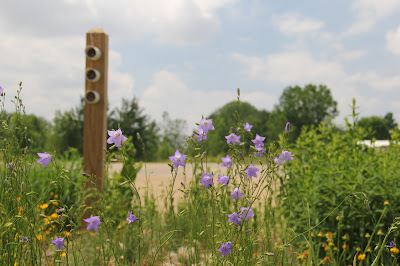Saginaw Chippewa Academy
The garden at the Saginaw Chippewa Academy underwent a major transition this year. The portable classroom that previously bordered the west side of the garden was removed this spring. This means that the garden is no longer receiving lots of runoff from the building's roof. It is also nor getting full sun all day long. These two factors mean that it should be much drier this year than in the past. What the long term impact will be remains to be seen.
 |
| SCA Native Pollinator Garden |
 |
| Lance-leaf Coreopsis is almost done blooming |
 |
| Lance-leaf Coreopsis |
 |
| Harebell with a bee nesting tower in the background |
 |
| Harebell |
 |
| Cup Plant leaves |
Mt. Pleasant Discovery Museum
This is the first site that people see a the enter the Mt. Pleasant Discovery Museum. It gets lots of foot traffic on its path. It also gets a lot of runoff from the roof - enough that erosion can be a problem. The plants here are expanding to fill empty space, but they still have a long way to go. Coreopsis is threatening to overgrow the path on the west end - other plants are spreading more slowly. I did see lots of the Museum's honey bee visiting the garden while I was there. Overall, I am pleased with the progress this garden has made.
 |
| Mt. Pleasant Discovery Museum Native Pollinator Garden |
 |
| Black-eyed Susan will eventually give way to other plants |
 |
| Common Milkweed |
 |
| This garden is certified as a Monarch Waystation (as are the other three) |
 |
| Hoary Vervain |
 |
| Prairie Dock leaves |
Winn Elementary
This garden has two distinct zones. The part tucked back in the corner of the school is partially shaded and gets lots of runoff from the roof. The north end of the garden doesn't get as much water and receives more sunlight. As a result, the plants on this end have never really taken off as I had hoped. In the long run I will need to add more plants here to fill in the empty spaces.
 |
| Winn Elementary Native Pollinator Garden |
 |
| The north end of the garden |
 |
| New Jersy Tea |
 |
| Coreopsis along the sweeping edge of the garden |
 |
| The south part of the garden |
 |
| Coreopsis |
Morey Public School Academy
This garden is one of the younger gardens (created in 2013 along with the Discovery Museum garden). It gets full sun and a small amount of runoff. The most striking feature of this garden is the Prairie Dock. There are a couple dozen of these large plants. By late summer, their leaves may be two feet long and the flower stalks may be eight feet tall. Despite being rooted in clay, the plants that survived here are generally thriving. I need to transplant a number of plants that have self-sown in the walkways.
 |
| Common Milkweed and the Monarch Waystation sign |
 |
| Common Milkweed |
 |
| Runaway Lance-leaf Coreopsis |
 |
| Prairie Dock (left) and Lance-leaf Coreopsis (right) |
 |
| Prairie Dock leaves |
No comments:
Post a Comment